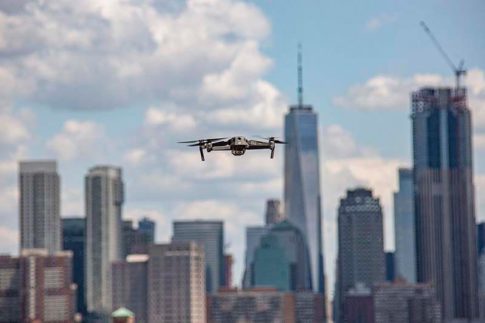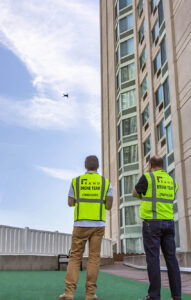
The New York City Department of Buildings is studying the use of drones in facade inspections.
As head of RAND's Drone Team, I, along with my team members, have been advocating to expand the use of drones to enhance facade inspections within New York City. Currently, while many U.S. cities allow the use of drones for building inspections with approval of the FAA, drone usage within much of Manhattan is not possible due to local laws, DOT restrictions, and NYPD procedures. However, as reported by Habitat Magazine, "The New York City Council has ordered the Department of Buildings (DOB) to study the safety and feasibility of permitting drones to augment facade inspections... A bill sponsored by three Democrats – Robert Cornegy of Brooklyn, Ben Kallos of Manhattan and Paul Vallone of Queens – orders the DOB to determine whether the flying of drones would conflict with any rules by city agencies or the Federal Aviation Administration (FAA), and if drones have the potential to increase public safety and reduce the need for sidewalk sheds."
For now, our drone team has been working on projects in the outer boroughs and outside the city. Drone usage can add another layer of safety by improving the quality of visual inspections, therefore better protecting against facade-related accidents and deaths due to defective pieces of the wall (most recently terra cotta) falling onto the busy sidewalk below. Drones can provide a birds-eye perspective of failed conditions and all other locations along the facade where similarly defective conditions may be present. This would improve the effectiveness of the emergency response to these types of accidents, perhaps even preventing additional accidents from occurring at a given site.

Drones can capture detailed, high-resolution video and photos from any vantage point for close-up inspections.
Drones and FISP
To clarify a common misconception, while drones can allow for a very effective, close-up visual inspection, they do not take the place of hands-on inspections, which are required as part of the city's Facade Inspection Safety Program (FISP), formerly known as Local Law 11, which mandates the inspection of buildings six stories and taller every five years. The FISP process involves first a visual inspection from the street level and then hands-on inspection from hanging scaffolds, boom lift, or IRA (Industrial Rope Access). The visual part of the inspection typically utilizes binoculars and high-powered camera lenses to get an overall sense of facade conditions in advance of the hands-on Inspection. Drone usage for FISP work would be considered part of the visual inspection, and the advantage is it takes the eyes from street level to up-close.
Another advantage is efficiency. All forms of hands-on inspection require filing with the DOB, a process that can take several weeks, not to mention the time then required to coordinate with building staff once approval is obtained and set up the equipment. Again, while drones do not substitute for the eventual hands-on inspection, they do allow for a quick close-up visual inspection of potential problem areas, to more quickly start the clock on diagnosis, which is then followed by emergency protection and repair where needed.
For Those Difficult-to-Access Areas
Drones are also useful where it may be cost-prohibitive, unsafe, or impractical to use other methods for building inspections because of the shape and location of the structure and/or its condition. Recently, our drone team investigated difficult-to-access leaks at a 183-unit, 12-story cooperative in Guttenberg, N.J. that is situated at the top of a steep, heavily wooded cliff. The building's garage hangs over the cliff, and the only way to inspect the integrity of the underside of the garage without a drone would have been to build a scaffold on the wooded cliff. Our drone team was able to take high resolution photos and videos to give us a very detailed look of the areas in question efficiently and cost-effectively.
The new law needs to address what a drone can safely do. For now, the DOB’s report to the city council, which was due June 30, has been delayed by the coronavirus pandemic. We have high hopes that Int. No. 1853-2020 will be passed as the first step toward initiating commonplace drone usage in New York City by qualified professionals, a change that will enable engineering and architectural firms to provide better quality facade inspections and greatly enhance public safety.
For more about our efforts to expand the use of drones for facade inspections, read "City Council Exploring Use of Drones in Facade Inspections" in Habitat Magazine.
Brett Rieger, AIA is a registered architect and QEWI. He is RAND's Drone Team Leader and Project Architect on RAND's Facade and Roofing Team.
